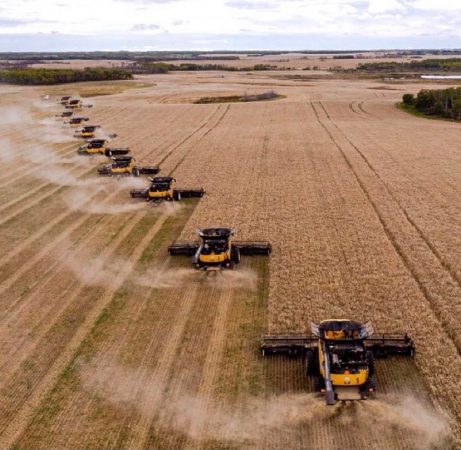
A seed-to-fork tracing system allows Above Food to ‘own’ its supply chain
By Nithya Caleb
Business Operations Sustainability Plant-based foods Above Food Culcherd Eat up! by Above Food Editor pick Farmer Direct organic food traceability Only Oats Saskatchewan
Above Food, a plant-based food and beverage brand from Canada, offers a suite of more than 40 products ranging from pizza crusts and meat substitutes to plant-based cheese and butters. Above Food also takes a seed-to-fork approach, meaning their products are not curated in labs, but rather made with “real ingredients, real nutrition, real flavour and real transparency.”
The house of brands available on the Above Food platform include Eat Up! by Above Food (Above Food’s namesake line of regenerative-natural, plant-based products), Farmer Direct Organic (organic pantry staples), and two recently acquired oat-based products – Only Oats (gluten-free, oat-based ingredients and consumer products) and Culcherd (organic, plant-based dairy products).
I interviewed Martin Williams, co-founder, chief innovation officer and president of Above Food, about the company’s seed-to-fork tracing system.

Martin Williams
Please briefly explain Above Food’s seed-to-fork approach?
MW: Above Food is a first-of-its-kind plant-based food company, building a completely vertically integrated platform from farm-gate to dinner-plate. With chain-of-custody of plant proteins and plant ingredients, enabled by scaled cultivation, operations and infrastructure in primary agriculture and ingredient processing, Above Food delivers proprietary ingredients, and differentiated consumer products to businesses and consumers with a commitment to traceability, sustainability and superior nutrient density.
Why was it important to adopt this approach?
MW: Above Food’s vision is to create a healthier world – one seed, one field and one bite at a time. In order to do this we need to have greater oversight of our entire value chain.
Our complete custody model, which we call the Above Platform Difference, allows us to deliver novel ingredients and products that solve real issues in the food system because we can control what seed genetics are planted and how it is harvested, transported, stored and processed. We will then take these ingredients and use them across our four consumer brands. Additionally, we are working to partner with other food companies to help them solve functional and nutritional issues through our advanced ingredients and proprietary formulations. We know not all protein is created equal, and that plant-based products need to be more densely nutritious, and with our platform we get to help solve for this.

Please expand on the vertically integrated aspects of the business.
MW: Our entire platform is built on vertical integration, so this is both our operating model and business model.
The future of plant-based foods actually looks a lot like the early history of food production. If we think back to when General Mills needed to be an actual mill – by necessity, in order to produce their ingredients and products – this is what we’re doing. Control the crop, means of production and the brands.
We have deep knowledge and experience across the food production ecosystem that has allowed us to create this first-of-its-kind vertically integrated platform. We have decades of ag-tech experience, four generations of food production experience, dating back to 1899, and decades of CPG experience – amongst our founding partners and leadership team.
From an agriculture perspective, we have a distinct geographic advantage with our global head offices outside of Regina, Sask. The best plant proteins are grown in the southern prairies of Canada and the northern plains of the United States. Our climate in these northern latitudes means we have less pests, and the 17+ hours of sunshine in the middle of the summer lends itself well to these incredible phototropic proteins.
This means we start with better inputs, plant proteins and plant ingredients like chickpeas, lentils, faba, peas, oats, to name just a handful. Each grown more naturally and more sustainably. Each managed, traced and tracked through our infrastructure. Better inputs results in better outputs downstream, such as more nutritious and functional ingredients and sustainably produced consumer products.
Take our Farmer Direct Regenerative Organic Platform (FDO) as an example. We work with organic farmers of all scales to contract their plant proteins, tracing their origin down to the field it was grown on, and monitoring how it was harvested, processed and packed for both retail and wholesale. We know precisely who, and what has touched these every step of their journey. As a testament to this, each FDO product package features a unique traceability number. For those curious about their product’s background, we can share the full journey with them, and this year will be building a digital portal to more easily showcase this on our website.
Where are your ingredient processing/manufacturing facilities located?
MW: Currently, we have three ingredient processing facilities, each in Saskatchewan. We also partner with food tech and production partners in Saskatchewan. By producing products as close to the source as possible, we aim to minimize unnecessary transportation emissions and costs.
The lone exception is our plant-based dairy production facility, which is located in Toronto, closer to our largest current consumer market.
Please explain the processing technologies used to manufacture the plant-based ingredients.
MW: Our entire model is based on chain of custody, which is a fancy way of saying we can trace and track all of our proteins from the moment they enter our supply chain to the moment they leave it. We do this through our purpose-built infrastructure and partners who are committed to traceability, sustainability and nutrient density.
It starts with no-till agriculture, which creates a carbon sink at scale.
From a primary ingredient processing standpoint, we have scaled infrastructure built on an identity preserved model, which means we can own, trace and track up to 144 different unique, boutique ingredient/proteins at any one time and know exactly where and when these proteins were harvested. We have drying, cooling colour and size sorting and bagging as part of this stack.
From a food tech standpoint, we are spoiled for riches in terms of the quantity and quality of talented food scientists and production partners, part of an advanced protein eco-system in Western Canada. For products like our Eat Up! Seasoned Plant-based Meat Crumbles, the same type of vertical integration we illustrated for FDO will apply. We own the plant protein in the fields, will transform these into unique pulse protein concentrates and isolates, keeping more of the fibre and starch intact, which we will then use as the protein base. We are currently working on a unique multi-pulse concentrate and isolate blend, which will deliver higher micro- and macro-nutrients. These are being created with unique air classification processes, which helps preserve the integrity of the nutrients.
From a consumer product production standpoint, we have co-packing relationships for our plant-based meats, where twin screw extrusion is used to produce the right texture.
For our plant-based cheese and butters, we own our own facility and use a process that blends age-old fermentation techniques from the artisanal dairy industry with proprietary plant-based approaches to create dairy alternatives rich in probiotics that not only provide a distinct dairy-like taste and mouthfeel, but also offer incredible gut health benefits.
Print this page